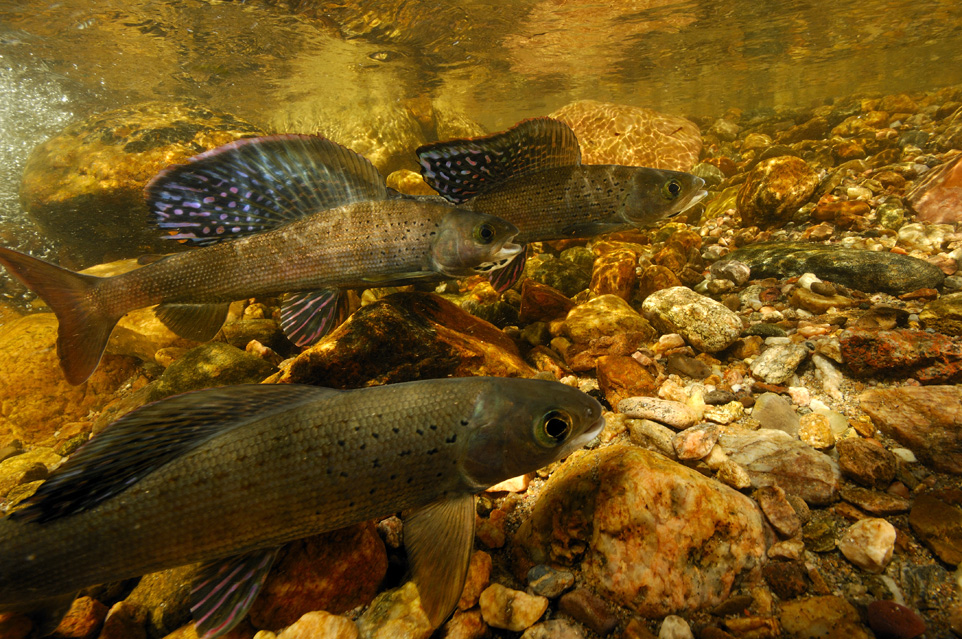Conservation Groups Launch Lawsuit to Protect Montana Grayling
Rare fish still threatened by massive water diversions from Big Hole River
Contact
The Center for Biological Diversity, Western Watersheds Project, Butte resident Pat Munday and former Montana fishing guide George Wuerthner today filed a formal notice of intent to sue the U.S. Fish and Wildlife Service over the agency’s latest decision to deny protection to a unique population of Arctic grayling in Montana. The Service first determined the grayling warranted endangered status in 1994 and reaffirmed that conclusion in 2010, but reversed course in August, withholding protection from the rare and beautiful relative of trout and salmon. The groups are represented by Earthjustice in Bozeman.
“Montana’s unique grayling are on the brink of extinction and should have been protected under the Endangered Species Act,” said Noah Greenwald, endangered species director at the Center. “Efforts by the state and some ranchers to improve habitat for the grayling are commendable, but just have not been enough to reverse the grayling’s perilous decline.”
In denying the grayling protection, the agency argued that voluntary efforts by private landowners and the state of Montana guided by a conservation agreement in place since 2006 have alleviated threats to the fish’s survival. Although many individual projects to improve habitat have been completed under the agreement, the grayling continues to face many threats and survives in very small numbers in just 4 percent of its historic range.
“Voluntary efforts to improve Arctic grayling habitat are important, but have not been enough to rescue this magnificent, native fish from the brink of extinction,” said Earthjustice attorney Adrienne Maxwell who is representing the groups. “Montana’s Arctic grayling cannot survive without more water in the Big Hole River, and getting that done requires Endangered Species Act listing and the national conservation commitment that goes with it.”
Once found throughout the upper Missouri River drainage above Great Falls, native populations of Montana grayling have been reduced to a short stretch of the Big Hole River, a few small lakes in the area, and a small population reintroduced in the Ruby River. A primary factor in the decline of the species’ range has been the ongoing diversion of water from the grayling’s stream habitat for agricultural uses and degradation of riparian areas. Extensive water withdrawals from the Big Hole River that draw down the river to a mere trickle every summer continue to threaten the Big Hole population. Listing under the Endangered Species Act would require the creation of a federal conservation plan to address low flows in the Big Hole, among other threats.
“There is no way to ensure the survival of the grayling without leaving enough water in the river and protecting the stream and streambanks from habitat degradation,” said Travis Bruner, executive director of Western Watersheds Project. “The Fish and Wildlife Service’s reliance on voluntary reductions in water use offers cold comfort in the face of near extinction of a species.”
“This is about more than saving the grayling, this is about saving a national treasure—the Big Hole River,” said noted conservationist and former Montana fishing guide George Wuerthner. “The Endangered Species Act is incredibly effective at protecting and recovering species, but only if protection is provided. It’s a travesty that the grayling has been waiting for protection for 32 years.”
“It is incredibly sad that we must sue the Fish & Wildlife Service to follow the law and protect grayling,” added Pat Munday, a college professor who authored a popular book about the Big Hole River. “The agency claims that grayling numbers are increasing, but provides no credible, statistically valid evidence for this claim. In fact, when you examine the data, it appears that there is a consistent, long-term decline in the grayling population.”
Background
A member of the salmon family, the Arctic grayling is a beautiful fish with a prominent dorsal fin. The species thrives in cold freshwater streams and rivers across Canada and Alaska. Historically, fluvial populations of Arctic grayling existed in only two places in the lower 48 states: Michigan and the upper Missouri River of Montana. Populations in Michigan went extinct by the 1930s and populations in Montana were restricted to the Big Hole River and a few lakes by the end of the 1970s. Studies demonstrate that Montana grayling are genetically distinct from populations in Canada and Alaska.
The grayling was first petitioned for listing by the Biodiversity Conservation Alliance, now part of the Center for Biological Diversity, and George Wuerthner in 1991, leading to the Fish and Wildlife Service’s first finding that the grayling warranted endangered status in 1994. Rather than providing that protection, however, the agency put the fish on a candidate list, where it received no protection. The grayling subsequently experienced severe declines in response to the near drying-up of the Big Hole River on an annual basis caused by increased irrigation use and drought. Fearing the extinction of the fish, the Center, Western Watersheds Project, and Wuerthner sued for protection in 2003. In 2005 the Fish and Wildlife Service agreed to issue a new decision on listing, but rather than list the species, the agency reversed course and denied it protection, arguing that extinction of the Montana population would be insignificant. The groups again sued and in 2010, the Fish and Wildlife Service once again reversed course, concluding that the grayling warranted protection, but again only added it to a candidate list. In 2011, the Center reached a settlement agreement requiring the agency to either move forward with protection or withdraw such protection by the end of fiscal year 2014, resulting in the most recent reversal and denial.

Additional Resources
About Earthjustice
Earthjustice is the premier nonprofit environmental law organization. We wield the power of law and the strength of partnership to protect people's health, to preserve magnificent places and wildlife, to advance clean energy, and to combat climate change. We are here because the earth needs a good lawyer.